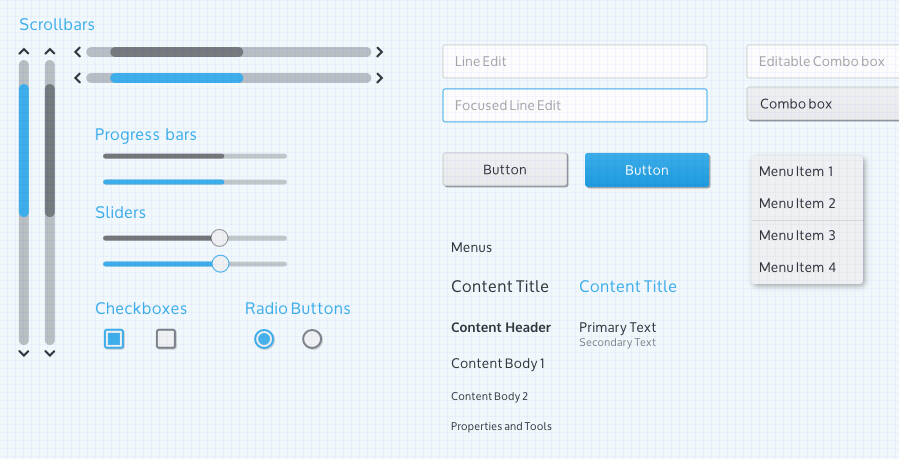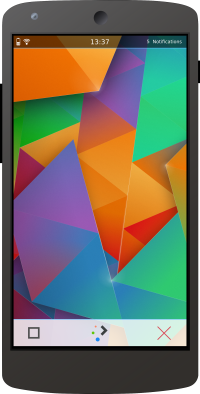Plasma Mobile is developed in a design-driven workflow. We design features and applications with Plasma Mobiles core concerns of functionality and privacy and design the apps fitting to different form factors. Apps or system components can be specific for a device such as a smartphone, but may also be applicable and useful on other types of devices, such as laptops.
Design process¶
This design process is iterative in nature and combines input from interaction designers, visual designers and developers in all stages. A guideline for a design process looks could be:
Requirements analysis¶
The first step to building an application is to analyze the problem that you want to solve and come up with a way how you can solve this problem. This allows you to make a list of required features for your application. A clear purpose and understanding of what want to achieve and how you want to get there helps you to make smart choices regarding features, their design and presentation. It can also avoid bloat and helps to set priorities for the app’s development work.
In this phase, try to answer the following questions:
Which problem do we want to solve?
How do we want to solve this problem (may be on an abstract level)?
Which user-facing functional changes do we want to make?
Interaction design¶
In the interaction design stage, the requirements are translated into functional additions or changes.
How does the user “experience” the described functionality?
Where does the new feature fit into the application’s workflow?
How should this be presented in terms of interactive controls?
Which options should be provided?
How can these actions be labeled and presented to the user in a self-explanatory way?
Visual design¶
The visual design stage is all about how it should look on the screen. Relevant questions that should be answered in this stage are:
How should the wanted functionality be presented?
Which graphical elements are necessary for functional and visual aspects of the new feature?
Which supporting hints, such as animation or transition effects should be provided, and which function do they serve?
Which graphical elements are necessary, on top of existing theming and graphical elements
Mockups are useful tools to convey results of this stage in order to move on to the next stage.
Implementation¶
In this stage, the developer works on the code for the application, getting feedback or additional details from the previous stages. This work can be done based on mockups and it’s generally helpful when someone has already thought of which UI options should be found where. Good presentations of the design work help developers to make smart choices in the architecture. Developers are usually happy to receive mockups that look good, and try to make the resulting UI match (or exceed) the ideas of the designers.
Review¶
In this stage, we have a critical look at the result of the implementation and look how it can be improved or polished further. Review should blend into the implementation stage as soon as possible, as to steer the development of the UI in the expected direction.
Profit!¶
The feature reaches the user, through testing packages and eventually in a stable release, via system images, packages or app stores. This is just the beginning, since it’s the point where feedback comes in, often in the form of bugreports, but also regularly in comments from ragingly enthusiast users that appreciate the work done. Time to think about the next iteration, how can the feature be made more valuable, better understandable, or just a lot more appealing or useful?
Design tools¶
The following tools help you to design a well-integrated, good looking and functional application or feature.
Vision statement¶
Plasma Mobile is designed based on the following vision statement: “Plasma Mobile aims to become a complete software system for mobile devices. It is designed to give privacy-aware users back the full-control over their information and communication. Plasma Mobile takes a pragmatic approach and is inclusive to 3rd party software, allowing the user to choose which applications and services to use. It provides a seamless experience across multiple devices. Plasma Mobile implements open standards and it is developed in a transparent process that is open for the community to participate in.”
Personas¶
Based on the vision statement, applications should be designed for the following personas (from techbase):
Berna the office worker¶
Berna is an office worker, she says “I want to feel safe”.

Berna works as an office clerk in a big insurance company. Although she is a very smart person, she is very often unsure how technology can help her.
Berna’s biggest daily task is to check on the details of insurance claims. She writes reports for her boss suggesting compensation payouts for the cases she deals with. Berna is a very detail oriented individual, and always resolves her tasks accurately.
Berna lost several hours of work twice because she didn’t understand the options she was offered with technology. Since then, she has been very careful when testing new functionality in the software she uses. She prefers to keep things simple.
Recreational user¶
“Susan” is a recreational user, her motto is “I want to be creative and flexible”.

While Susan seldom uses her computer for work, it has become an essential part of her social life. With her computer, she can be creative and spread this creativity to the world.
She chats with her friends, shares music, playlists and other media, creates videos and uploads them to her web space, and runs a blog with her own style. She can’t imagine a life without her laptop.
She is a fun person and does not want to worry about technical details. She expects her machine to work.
Human Interface Guidelines¶
We are currently working on extending KDE’s Human Interface Guidelines also for mobile devices. This is an area where your expertise and help would be much appreciated.
Mockup toolkit¶

VDGMockupKit1.png¶
Mockups can be used to design the visual layout of each screen of an application, without writing code. The mockup toolkit is provided as an Inkscape SVG with each Building Block UI element and sample mocked applications. This kit is centered around desktop design for now but will be refined later for phone design.
Find more information about mockup toolkit here.
A simple frame to use for future phone mockups based on the Nexus 5:

Mockup2.png¶
Contribute¶
Coordination of design related topics is done in the Plasma Mobile Matrix room. For more community groups and channels check the relative web page. You may also interested in joining the KDE Visual Design Group and start discussing design topics in the relative Matrix room. More KDE VDG communication channels can be found here.